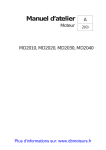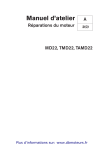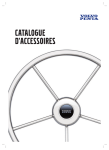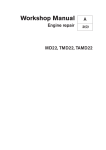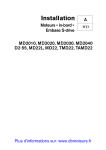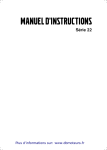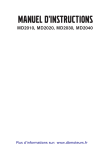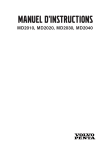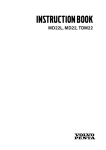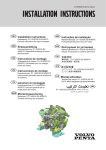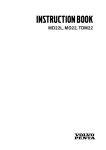Download Volvo Penta MD22 Technical data
Transcript
Workshop Manual Wiring diagram A 2(0) MD2010, MD2020, MD2030, MD2040 MD22, TMD22, TAMD22 Grupp 30 Electrical system Wiring diagram MD2010A/B/C/D, MD2020A/B/C/D MD2030A/B/C/D, MD2040A/B/C/D MD22A, MD22L-B, MD22P-B TMD22A, TMD22-B, TMD22P-C TAMD22P-B Contents Safety Information ......................................... 2 General Information....................................... 5 Wiring diagram ............................................... 6 Engine 2010 - 2040A ........................................ 6 Engine 2010 - 2040B/C/D ................................ 8 Engine MD22A - TAMD22P-B ......................... 10 Instrument panel with ignition switch (option 1) . 12 Instrument panel with ignition switch (option 2) 14 Instrument panel with starter button .................. 16 Instrument kit .................................................... 18 Diode cable ..................................................... 20 SX Power Trim ................................................ 22 Active anti-corrosion system ........................... 28 ............................................................................ ............................................................................ ............................................................................ ............................................................................ 1 Safety information Introduction This Workshop Manual contains technical data, descriptions and repair instructions for Volvo Penta products or product versions contained in the contents list. Ensure that the correct workshop literature is being used. Read the safety information and the Workshop Manual “General Information” and “Repair Instructions” carefully before starting work. Check that the warning or information decals on the product are always clearly visible. Replace decals that have been damaged or painted over. Never start the engine without installing the air cleaner (ACL). The rotating compressor in the turbocharger can cause serious personal injury. Foreign objects entering the intake ducts can also cause mechanical damage. Important In this book and on the engine you will find the following special warning symbols. WARNING! If these instructions are not followed there is a danger of personal injury, extensive damage to the product or serious mechanical malfunction. IMPORTANT! Used to draw your attention to something that can cause damage, product malfunction or damage to property. NOTE! Used to draw your attention to important information that will facilitate work or operations. Below is a summary of the risks and safety precautions you should always observe or carry out when operating or servicing the engine. Immobilize the engine by turning off the power supply to the engine at the main switch (switches) and lock it (them) in the OFF position before starting work. Set up a warning notice at the engine control point or helm. Never use start spray or similar to start the engine. The starter element may cause an explosion in the inlet manifold. Danger of personal injury. Avoid opening the coolant filler cap when the engine is hot. Steam or hot coolant can spray out. Open the coolant filler cap carefully and slowly to release pressure before removing the cap completely. Take great care if a cock, plug or engine coolant line must be removed from a hot engine. It is difficult to anticipate in which direction steam or hot coolant can spray out. Hot oil can cause burns. Avoid skin contact with hot oil. Ensure that the lubrication system is not under pressure before commencing work on it. Never start or operate the engine with the oil filler cap removed, otherwise oil could be ejected. Stop the engine before carrying out operations on the engine cooling system. Generally, all servicing should be carried out with the engine switched off. Some work (carrying out adjustments for example) requires that the engine is running. Approaching a running engine is dangerous. Loose clothing or long hair can fasten in rotating parts and cause serious personal injury. If working in proximity to a running engine, careless movements or a dropped tool can result in personal injury. Avoid burns. Take precautions to avoid hot surfaces (exhausts, turbochargers, charge air pipes and starter elements etc.) and liquids in supply lines and hoses when the engine is running or has been turned off immediately prior to starting work on it. Reinstall all protective parts removed during service operations before starting the engine. 2 Start the engine only in a well-ventilated area. If operating the engine in an enclosed space, ensure that exhaust gases are ventilated out of the working area. Always use protective goggles where there is a danger of pieces of metal, sparks from grinding, acid or other chemicals being thrown into your eyes. Your eyes are very sensitive, injury can lead to loss of sight! Avoid skin contact with oil. Long-term or repeated contact with oil can remove the natural oils from your skin. The result can be irritation, dry skin, eczema and other skin problems. Used oil is more dangerous to health than new oil. Use protective gloves and avoid using oil-soaked clothes and rags. Wash regularly, especially before meals. Use the correct barrier cream to prevent dry skin and to make cleaning your skin easier. Most chemicals used in products (engine and transmission oils, glycol, petrol and diesel oil) and workshop chemicals (solvents and paints) are hazardous to health Read the instructions on the product packaging carefully! Always follow safety instructions (using breathing apparatus, protective goggles and gloves for example). Ensure that other personnel are not unwittingly exposed to hazardous substances (by breathing them in for example). Ensure that ventilation is good. Handle used and excess chemicals according to instructions. Be extremely careful when tracing leaks in the fuel system and testing fuel injection nozzles. Use protective goggles! The jet ejected from a fuel injection nozzle is under very high pressure, it can penetrate body tissue and cause serious injury There is a danger of blood poisoning. All fuels and many chemicals are inflammable. Ensure that a naked flame or sparks cannot ignite fuel or chemicals. Combined with air in certain ratios, petrol, some solvents and hydrogen from batteries are easily inflammable and explosive. Smoking is prohibited! Ensure that ventilation is good and that the necessary safety precautions have been taken before carrying out welding or grinding work. Always have a fire extinguisher to hand in the workplace. Store oil and fuel-soaked rags and fuel and oil filters safely. In certain conditions oil-soaked rags can spontaneously ignite. Replaced fuel and oil filters are environmentally harmful waste and should be disposed of at proper disposal areas together with engine and transmission oil, contaminated fuel, old paint, degreasing agents, and cleaning residue. Never allow a naked flame or electric sparks near the batteries. Never smoke in proximity to the batteries. The batteries give off hydrogen gas during charging which when mixed with air can form an explosive gas - oxyhydrogen. This gas is easily ignited and highly volatile. Incorrect connection of the battery can cause a spark which is sufficient to cause an explosion with resulting damage. Do not disturb battery connections when starting the engine (spark risk) and do not lean over batteries. Never interfere with the terminals when the system is operative. A high energy pulse may be generated which will damage the electrical system. Never mix up the positive and negative battery terminals when installing. Incorrect installation can result in serious damage to electrical equipment. Refer to wiring diagrams. Always use protective goggles when charging and handling batteries. The battery electrolyte contains extremely corrosive sulfuric acid. If this comes into contact with the skin, wash immediately with soap and plenty of water. If battery acid comes into contact with the eyes, immediately flush with copious amounts of water and obtain medical assistance. Turn off the engine and turn off power at main switch(es) before carrying out work on the electrical system. Clutch adjustments must be carried out with the engine turned off. Use the lifting eyes mounted on the engine when lifting the drive unit. Always check that lifting equipment is in good condition and has sufficient load capacity to lift the engine (engine weight including any extra equipment installed). To ensure safe handling and to avoid damaging engine components on top of the engine, use a lifting beam to raise the engine. All chains and cables should run parallel to each other and as perpendicular as possible in relation to the top of the engine. If extra equipment is installed on the engine altering its center of gravity, a special lifting device is required to achieve the correct balance for safe handling. Never carry out work on an engine suspended on a hoist. 3 Säkerhetsinformation Never remove heavy components alone, even where secure lifting equipment such as secured blocks are being used. Even where lifting equipment is being used it is best to carry out the work with two people; one to operate the lifting equipment and the other to ensure that components are not trapped and damaged when being lifted. The components in the electrical system and in the fuel system on Volvo Penta products are designed and manufactured to minimize the risk of fire and explosion. The engine must not be run in areas where there are explosive materials. Always use fuels recommended by Volvo Penta. Refer to the Instruction Book. The use of lower quality fuels can damage the engine. On a diesel engine poor quality fuel can cause the control rod to seize and the engine to overrev with the resulting risk of damage to the engine and personal injury. Poor fuel quality can also lead to higher maintenance costs. Säkerhetsinformation 4 General information About the workshop manual • This workshop manual contains technical data, descriptions and repair instructions for standard versions of the engine units. • This Workshop Manual has been developed primarily for Volvo Penta service workshops and qualified personnel. Persons using this book are assumed to have a grounding in the repair and service of diesel engines and be able to carry out related mechanical and electrical work. Volvo Penta is continuously developing their products. We therefore reserve the right to make changes. All the information contained in this book is based on product data available at the time of going to print. Any essential changes or modifications introduced into production or updated or revised service methods introduced after the date of publication will be provided in the form of Service Bulletins. • The engine must not be modified in any way apart from with accessories and service kits developed for it by Volvo Penta. No modifications to the exhaust pipes and air supply ducts may be undertaken as this may effect exhaust emissions. Seals may only be broken by authorized personnel. IMPORTANT! Use only Volvo Penta Genuine Parts. Use of non-original AB Volvo Penta spare parts will result in AB Volvo Penta being unable to assume liability for the engine meeting engine certification requirements. No damage and costs caused by the use of non-genuine replacement parts will be paid by Volvo Penta. Replacement parts Replacement parts for electrical and fuel systems are subject to statutory requirements (US Coast Guard Safety Regulations for example). Volvo Penta Genuine parts meet these requirements. Any type of damage which results from the use of non-original Volvo Penta replacement parts for the product will not be covered under any warranty provided by Volvo Penta. Certificated engines Engines certificated to meet national and regional environmental legislation carry with them an undertaking from the manufacturer that both new and existing engines in use meet the environmental demands of the legislation. The product must be the same as the example approved for certification purposes. So that Volvo Penta, as a manufacturer, can guarantee that currently operational engines meet environmental regulations, the following service and replacement part requirements must be observed: • • • The Service Intervals and maintenance operations recommended by Volvo Penta must be observed. Only Volvo Penta genuine replacement parts, intended for the certificated engine, may be used. The servicing of injector pumps, pump settings and injectors must always be carried out be an authorized Volvo Penta workshop. 5 Engine MD2010A–2040A 1,5-pole* electrical system * 1 pole during the start and stop phases, 2 pole at all other times. 6 Engine MD2010–2040A (1.5-pole electrical system) 1. 2. 3. 4. 5. 6. 7. 8. 9. 10. 11. 12. 13. 14. 15. 16. 17. 18. Battery Main switch Starter motor Ground relay Ground rail Glow plugs* Generator Starter relay Glow plug relay Protective diode** Fuses (x4), maximum 15A (+) Fuses (x4), maximum 15A (–) Cable splice Engine oil pressure switch (normally open, closes below 0.3 ± 0.1 bar) Oil pressure sensor Coolant temperature switch (normally open, closes at 95° ± 3°C) Engine coolant temperature sensor Connector, 16-pin Cable color BL = LBL = BN = LBN = GN = GR = OR = Blue Light-blue Brown Light-brown Green Gray Orange P PU R SB VO W Y = = = = = = = Pink Purple Red Black Violet White Yellow Cable cross sections in mm2 are indicated after the colour codes in the wiring diagram. Cable cross sections not indicated = 1.5 mm². A dashed line indicates a non-Volvo Penta cable. * MD2010: x 2 Other engines: x 3 ** Non-standard on earlier models. 7 Engine MD2010–2040B/C/D 1-pole electrical system 8 Engine MD2010–2040B/C/D (1-pole electrical system) 1. 2. 3. 4. 5. 6. 7. 8. 9. 10. 11. 12. 13. 14. Battery Main switch Starter motor Generator Glow plugs Starter relay Glow plug relay Fuses (x4), maximum 15 A Charging regulator resistance 33/9 W Engine oil pressure switch (normally open, closes below 0.3 ± 0.1 bar) Oil pressure sensor Coolant temperature switch (normally open, closes at 100° ± 2°C) Engine coolant temperature sensor Connector, 16-pin Cable color BL = LBL = BN = LBN = GN = GR = OR = Blue Light-blue Brown Light-brown Green Gray Orange P PU R SB VO W Y = = = = = = = Pink Purple Red Black Violet White Yellow Cable cross sections in mm2 are indicated after the colour codes in the wiring diagram. Cable cross sections not indicated = 1.5 mm². A dashed line indicates a non-Volvo Penta cable. 9 Engine MD22A, MD22L-B, MD22P-B TMD22A, TMD22-B, TMD22P-C, TAMD22P-B 1,5-pole electrical system * 1 pole during the start and stop phases, 2 pole at all other times. 10 Engine MD22A – TAMD22P-B (1.5-pole electrical system) 1. 2. 3. 4. 5. 6. 7. 8. 9. 10. 11. 12. 13. 14. 15. 16. 17. 18. 19. Battery Main switch Starter motor Generator Ground relay Fuse 55 A Automatic fuse 8 A Starter relay Glow plug relay Glow plugs (x4) Oil pressure switch - Engine, combined Oil pressure sensor - Engine, combined Solenoid valve Coolant temperature switch - Engine Coolant temperature sensor - Engine Automatic fuse 8 A Resistance Cable splice CPC connector, 16-pin Cable color BL = LBL = BN = LBN = GN = GR = OR = Blue Light-blue Brown Light-brown Green Gray Orange P PU R SB VO W Y = = = = = = = Pink Purple Red Black Violet White Yellow Cable cross sections in mm2 are indicated after the colour codes in the wiring diagram. Cable cross sections not indicated = 1.5 mm². A dashed line indicates a non-Volvo Penta cable. 11 Instrument panel with ignition switch (alt.1) MD2010–2040A/B/C/D MD22A, MD22L-B, MD22P-B TMD22A, TMD22-B, TMD22P-C, TAMD22P-B 12 Instrument panel with ignition switch MD2010 – 2040A/B/C/D and MD22A – TAMD22P-B Spring loaded 1. 2. 3. 4. 5. 6. 7. 8. 9. 10. 11. 12. 13. 14. 15. 16. 17. 18. Instrument lighting — — — Connector for extra warning display (accessory) Alarm unit Engine coolant temperature warning lamp Oil pressure warning lamp Charge warning lamp Warning lamp (not used) Instrument lighting switch Alarm test/acknowledgement switch Tachometer with built-in hours run meter Ignition switch Alarm (buzzer) Splice connector CPC connector, 16-pin Power supply 30 for the tachometer (only later models) Spring loaded Cable color BL = LBL = BN = LBN = GN = GR = OR = Blue Light-blue Brown Light-brown Green Gray Orange P PU R SB VO W Y = = = = = = = Pink Purple Red Black Violet White Yellow Cable cross sections in mm2 are indicated after the colour codes in the wiring diagram. Cable cross sections not indicated = 1.5 mm². A dashed line indicates a non-Volvo Penta cable. 13 Instrument panel with ignition switch (alt.2) MD2010–2040A/B/C/D MD22A, MD22L-B, MD22P-B TMD22A, TMD22-B, TMD22P-C, TAMD22P-B 14 Instrument panel with ignition switch MD2010-2040A/B/C/D and MD22A – TAMD22P-B 1. 2. 3. 4. 5. 6. 7. 8. 9. 10. 11. 12. 13. 14. 15. 16. 17. 18. 19. Instrument lighting Voltmeter Oil pressure gauge Engine coolant temperature gauge Connector for extra warning display (accessory) Alarm unit Engine coolant temperature warning lamp Oil pressure warning lamp Charge warning lamp Warning lamp (not used) Instrument lamp switch Alarm test/acknowledgement switch Tachometer with built-in hours run meter Ignition switch Alarm (buzzer) Splice connector CPC connector, 16-pin Connector (not used) Power supply 30 for the tachometer (only later models) Spring loaded Spring loaded Cable color BL = LBL = BN = LBN = GN = GR = OR = Blue Light-blue Brown Light-brown Green Gray Orange P PU R SB VO W Y = = = = = = = Pink Purple Red Black Violet White Yellow Cable cross sections in mm2 are indicated after the colour codes in the wiring diagram. Cable cross sections not indicated = 1.5 mm². A dashed line indicates a non-Volvo Penta cable. 15 Instrument panel with starter button MD2010–2040A/B/C/D 16 Instrument panel with starter button MD2010 – 2040A/B/C/D 1. 2. 3. 4. 5. 6. 7. 8. 9. 10. 11. 12. 13. 14. 15. 16. Tachometer with built-in hours run meter Instrument lighting Connector for extra warning display (accessory) Alarm unit Engine coolant temperature warning lamp Oil pressure warning lamp Charge warning lamp Glow plug warning lamp Voltage On/Off button Start button Alarm (buzzer) Alarm/Glow plug rocker switch Neutral switch connector Semiconductor diode CPC connector, 16-pin Power supply 30 for the tachometer (only later models) Cable color BL = LBL = BN = LBN = GN = GR = OR = Blue Light-blue Brown Light-brown Green Gray Orange P PU R SB VO W Y = = = = = = = Pink Purple Red Black Violet White Yellow Cable cross sections in mm2 are indicated after the colour codes in the wiring diagram. Cable cross sections not indicated = 1.5 mm². A dashed line indicates a non-Volvo Penta cable. 17 Instrument kit MD2010–2040A/B/C/D MD22A, MD22L-B, MD22P-B TMD22A, TMD22-B, TMD22P-C, TAMD22P-B 18 Instrument kit 1. 2. 3. 4. 5. 6. 7. 8. 9. 10. 11. 12. 13. 14. 15. 16. Ignition switch Alarm test/acknowledgement switch Instrument lighting switch Alarm (buzzer) Alarm unit with warning lamps for: • Temperature • Oil level • Battery • Glow plugs Engine coolant temperature gauge Engine oil pressure gauge Voltmeter Boost pressure gauge Reverse gear oil pressure gauge Tachometer with built-in hours run meter Instrument lighting Connector, cannot be opened 9 Splice connector CPC connector, 16-pin Connector for extra warning display (accessory) Cable color BL = LBL = BN = LBN = GN = GR = OR = P = PU = R = SB = VO = W = Y = Blue Light-blue Brown Light-brown Green Gray Orange Pink Purple Red Black Violet White Yellow 19 Diode cable MD2010–2040A/B/C/D MD22A, MD22L-B, MD22P-B TMD22A, TMD22-B, TMD22P-C, TAMD22P-B 1.5-pole* electrical system * 1 pole during the start and stop phases, 2 pole at all other times. 20 Diode cable for 1.5-pole electrical system The diode cable is necessary for the engine to be stopped electronically, using the starter switch or the stop button. The diode cable also protects against short-circuits (cable burn out) if the battery positive terminal is unintentionally connected to the engine body. Outline diagram – Connection of diode kit A. Main panel B. Panel for alternative control position C. Diode kit D. Y connection E. Central electronic module (engine) Diode kit (C) 1. Diode 2. 16 pin CPC, to instrument panel 3. 16 pin CPC, to engine Cable color BL = LBL = BN = LBN = GN = GR = OR = Blue Light-blue Brown Light-brown Green Gray Orange P PU R SB VO W Y = = = = = = = Pink Purple Red Black Violet White Yellow Cable areas in mm2 are given after the color codes in the wiring diagram. 21 Power Trim SX-drev Power Trim SX without trim limiter (early production) 1. 2. 3. 4. 5a. 5b. 6. 7. 8a. 8b. 9a. 9b. 10a. 10b. 11. 12. 13. 14. 15. 16. 17. 18. 19. 20. Battery Main switch Starter Circuit breaker 50 A Connector, 2-pole male Connector, 2-poe female Hydraulic pump Connector with rubber cap, 3-pole Fully cast connectors, 3-pole female Fully cast connectors, 3-pole male Connector with rubber cap, 1-pole male Connector with rubber cap, 1-pole female Trim sender, digital Trim sender, analouge Connector, 7-pole Extension cable, Y-connector Control panel Triminstrument, analouge Instrument lightning Connecting terminal, instrument lightning (+) to main panel Connecting terminal, fuse box (–) to main panel Connecting terminal, fuse box (+) to main panel Circuit breaker 10 A Circuit breaker 10 A* Cable color BL = LBL = BN = LBN = GN = GR = OR = Blue Light-blue Brown Light-brown Green Gray Orange P PU R SB VO W Y = = = = = = = Pink Purple Red Black Violet White Yellow Cable areas in (mm2) are given after the cable color codes. Cable areas in brackets are AWG (American Wiring Gauge). Conversion table: mm2 0.5 0.75 1.0 1.5 AWG 20 18 17 15–16 mm 2 2.5 6 10 AWG 13 10 7 A broken line indicates a non-Volvo Penta cable. * Only certain executions of SX-C1, SX-CLT1, SX-C1AC, SX-R1 and SX-R2 23 Power Trim SX without trim limiter late production 1. 2. 3. 4. 5a. 5b. 6. 7. 8. 9. 10a. 10b. 11. 12. 13. 14. 15. 16. 17. 18. 19. 20. Battery Main switch Starter Circuit breaker 50 A Connector, 2-pole male Connector, 2-poe female Hydraulic pump Not used Connector, 1-pole Connector, 3-pole Fully cast connectors, 3-pole female Fully cast connectors, 3-pole male Connector 1-pole, trim by-pass Trim sender Extension cable, Y-connector Connector, 7-pole Control panel Triminstrument, analouge Instrument lightning Connecting terminal, instrument lightning (+) to main panel Connecting terminal, fuse box (–) to main panel Connecting terminal, fuse box (+) to main panel Cable color BL = LBL = BN = LBN = GN = GR = OR = Blue Light-blue Brown Light-brown Green Gray Orange P PU R SB VO W Y = = = = = = = Pink Purple Red Black Violet White Yellow Cable areas in (mm2) are given after the cable color codes. Cable areas in brackets are AWG (American Wiring Gauge). Conversion table: mm 2 0.5 0.75 1.0 1.5 AWG 20 18 17 15–16 mm2 2.5 6 10 A broken line indicates a non-Volvo Penta cable. 24 AWG 13 10 7 Power Trim SX, DP-S with trim limiter 1. 2. 3. 4. 5a. 5b. 6. 7. 8a. 8b. 9. 10. 11. 12. 13. 14. 15. 16. 17. 18. 19. 20. 21. Battery Main switch Starter Circuit breaker 50 A Connector, 2-pole male Connector, 2-pole female Hydraulic pump Not used Fully cast connectors, 3-pole female Fully cast connectors, 3-pole male Connector, 3-pole Connector, 1-pole Trim limiter Connector, 1-pole Trim sender Connector, 7-pole Extension cable, Y-connector Control panel Trim instrument, analouge Instrument lightning Connecting terminal, instrument lightning (+) to main panel Connecting terminal, fuse box (–) to main panel Connecting terminal, fuse box (+) to main panel Cable color BL = LBL = BN = LBN = GN = GR = OR = Blue Light-blue Brown Light-brown Green Gray Orange P PU R SB VO W Y = = = = = = = Pink Purple Red Black Violet White Yellow Cable areas in (mm2) are given after the cable color codes. Cable areas in brackets are AWG (American Wiring Gauge). Conversion table: mm 2 0.5 0.75 1.0 1.5 AWG 20 18 17 15–16 mm 2 2.5 6 10 AWG 13 10 7 A broken line indicates a non-Volvo Penta cable. 25 Power Trim SX without trim limiter BL 1,0 (17) 21 GN 0,5 (20) Y 0,5 (20) 22 SB 1,0 (17) 20 BN 0,5 (20) SB 1,0 (17) 19 R/BL 1,0 (17) GR 0,5 (20) W 0,5 (20) 2 3 1 4 5 7 6 2 3 1 4 5 7 6 24 16 BN/W 1,5 (16) PU/R O,75 (18) SB 1,5 (16) R/PU O,75 (18) R 0,75 (18) 18 GN/W 0,75 (18) BL/W 0,75 (18) 17 BN/BL 1,0 (17) 23 14b A C B 11 A W 13 SB** 15 SB* 14a 11 A C B C SB 1,5 (16) BN/W 1,5 (16) 12 BL 1,5 (16) GN 1,5 (16) SB 6,0 (10) 87a 87 85 6 R/PU 1,5 (16) SB 6 (10) 22-SX SB 10 (7) 31-SX SB 6 (10) 87a 87 R/PU 1,5 (16) 86 85 SB 1,5 (16) BL/W 6,0 (10) 30 SB 1,5 (16) R/PU 6,0 (10) 10 9 GN/W 6,0 (10) 30 SB 10 (7) 31-SX SB 6 (10) 22-SX R 6 (10) 22-SX R 10 (7) 31-SX R/PU 6 (10) 4 3 R 6 (10) 22-SX R 10 (7) 31-SX 86 R/PU 6,0 (10) R/PU 6,0 (10) 8 5b 5a 30 50 M 31-SX 31 7b 7a GN/W M 2 BL/W 1 1. 2. 3. 4. 5a. 5b. 6. 7a. 7b. 8. 9. 10. 11. 12. 13. 14a. Battery Main switch Starter Circuit breaker 50 A Connector, 2-pole male Connector, 2-pole female Fuse 10 A Connector, 2-pole male Connector, 2-pole female Hydraulic pump Reley, down Reley, up Connector with rubber cap, 3-pole Connector with rubber cap, 1-pole Not used Fully cast connectors, 3-pole female 14b. 15. 16. 17. 18. 19. 20. 21. 22. 23. 24. Fully cast connectors, 3-pole male Connector 1-pole Trim sender Connector, 7-pole Extension cable, Y-connector Control panel Triminstrument, analouge Instrument lightning Connecting terminal, instrument lightning (+) to main panel Connecting terminal, fuse box (–) to main panel Connecting terminal, fuse box (+) to main panel Cable color BL = LBL = BN = LBN = GN = GR = OR = SB* = Blue Light-blue Brown Light-brown Green Gray Orange Black ribbed P = PU = R = SB = VO = W = Y = SB** = Pink Purple Red Black Violet White Yellow Black smooth Cable areas in (mm2) are given after the cable color codes. Cable areas in brackets are AWG (American Wiring Gauge). Conversion table: mm2 0.5 0.75 1.0 1.5 2.5 6 10 AWG 20 18 17 15–16 13 10 7 A broken line indicates a non-Volvo Penta cable. 26 Power Trim SX with trim limiter 1. 2. 3. 4. 5a. 5b. 6. 7a. 7b. 8. 9. 10. 11a. 11b. 12. 13. 14. 15. 16. 17. 18. 19. 20. 21. 22. 23. 24. 25. Battery Main switch Starter Circuit breaker 50 A Connector, 2-pole male Connector, 2-pole female Fuse 10 A Connector, 2-pole female Connector, 2-pole male Hydraulic pump Reley, down Reley, up Fully cast connectors, 3-pole female Fully cast connectors, 3-pole male Connector with rubber cap, 3-pole Connector with rubber cap, 1-pole Not used Trim limiter Connector, 1-pole Trim sender Connector, 7-pole Extension cable, Y-connector Control panel Trim instrument, analouge Instrument lightning Connecting terminal, instrument lightning (+) to main panel Connecting terminal, fuse box (–) to main panel Connecting terminal, fuse box (+) to main panel Cable color BL = LBL = BN = LBN = GN = GR = OR = SB* = Blue Light-blue Brown Light-brown Green Gray Orange Black ribbed P PU R SB VO W Y SB** = = = = = = = = Pink Purple Red Black Violet White Yellow Black smooth Cable areas in (mm2) are given after the cable color codes. Cable areas in brackets are AWG (American Wiring Gauge). Conversion table: mm 2 0.5 0.75 1.0 1.5 2.5 6 10 AWG 20 18 17 15–16 13 10 7 A broken line indicates a non-Volvo Penta cable. 27 Active Corrosion Protection System 12 V 1. 2. 3. 4. 5. 6. Cable color BL = LBL = BN = LBN = GN = GR = OR = 28 Battery Fuse 1 A Active anode Reference sensor Electronic unit LED light Blue Light-blue Brown Light-brown Green Gray Orange P PU R SB VO W Y = = = = = = = Pink Purple Red Black Violet White Yellow Report form Do you have any complaints or other comments about this manual? Please make a copy of this page, write your comments down and post it to us. The address is at the bottom of the page. We would prefer you to write in English or Swedish. From: ............................................................................ ...................................................................................... ...................................................................................... ...................................................................................... Refers to publication: ............................................................................................................................................. Publication no.: ..................................................................... Issued: .................................................................... Suggestion/reasons: .............................................................................................................................................. .............................................................................................................................................................................. .............................................................................................................................................................................. .............................................................................................................................................................................. .............................................................................................................................................................................. .............................................................................................................................................................................. .............................................................................................................................................................................. .............................................................................................................................................................................. .............................................................................................................................................................................. Date: ............................................................ Name: .......................................................... AB Volvo Penta Customer Support Dept. 42200 SE-405 08 Gothenburg Sweden 7740536-3 English 05-2000

































